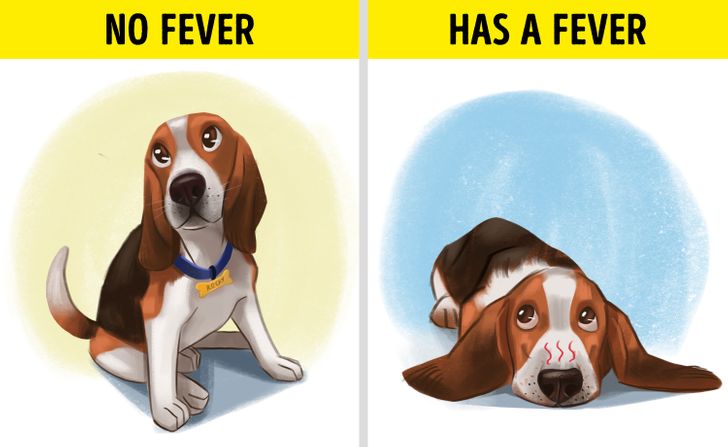Being a paw parent you’re probably aware of the nose method to know if your dog is running a fever: feel their nose- if it’s cold and wet, they’re fine, but if it is hot and dry then they probably have a fever. This method is most common among pet parents, which is not wrong but it’s not a reliable way to tell if your dog has a fever or not.

For an accurate assessment read further; in this blog, we will talk about the ways to confirm fever, signs, causes, and remedies for dog fever.
Normal Temperature for Dogs
Dogs, unlike humans, have a slightly higher body temperature. Our normal body temperature ranges between 97.6-99.6°F, whereas in dogs it is between 99.5-102.5°F. For dogs, if their temperature raises more than 103°F, only then it is called a fever. If your dog’s temperature reaches 106°F, it is a severe case and you should immediately call your veterinarian.
How to Measure Body Temperature in Dogs
While the nose method can tell you that your dog has a fever, it does not tell you the accurate temperature. To measure the body temperature of your dog, you have to use either a rectal thermometer or an ear thermometer. Both will show the correct measure; an ear thermometer is a bit more comfortable to use for your dog. Always read the instructions clearly and do not use glass thermometers.
Signs of Fever in Dogs
If you feel like your dog is not feeling well, then take note of their symptoms. Any of the following signs can be a reason to check their temperature and consult with your vet.

- Red or glassy eyes
- Warm ears or nose
- Shivering
- Panting
- Runny nose
- Lethargy
- Loss of appetite
- Coughing
- Vomiting
Causes of Dog Fever
There are many reasons why your dog gets sick and suffers from a high temperature:
- Infection– bacterial or fungal
- Ear infection
- Tooth infection
- Infection in the internal organs
- Urinary Tract infection
- Infected open wound
- Ingestion of poisonous materials
- Inflammation
- Vaccination: this causes a temporary spike in temperature. As vaccines cause an antibody reaction in bodies, fever for a few hours is normal.
- Fever of unknown origin (FUO): it can be caused by underlying disorders of the immune system or undiagnosed infections or cancer.
How to Treat a Dog Fever?

If the temperature of your dog is higher than 103F, immediately visit your vet. Till then you can try to cool them down by applying cold water with a soaked cloth to your dog’s paws and ears. You can even turn on a fan near them.
Make sure to stop these when the temperature falls below 103F. Moreover, it is important to keep them hydrated; try to persuade your dog to drink a small amount of water to stay hydrated, but don’t force it.
It is important to note that under any circumstances, you should NEVER give your dog treatments that are meant for human consumption. Only give them treatments meant for dogs or the ones that the vet has prescribed.
When you take your pooch to a vet, they will thoroughly examine your dog and decide on a course of action according to the reason for the fever. If your furry baby has a viral or bacterial infection, the vet will prescribe antibiotics. The treatment varies according to the severity of the illness.
Conclusion
There can be many reasons for your dog’s high temperatures. Sometimes, it might only be the result of a tiring playtime but sometimes it can be due to some underlying disease. Make sure that your dog stays healthy by determining the reason for the high temperature.
Understanding the signs and providing appropriate treatment will help you help your pooch to be healthy! You can always consult their veterinarian if you feel that they are very sick.

